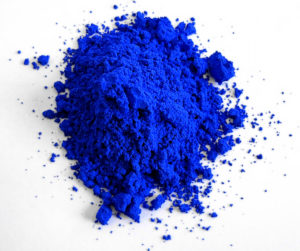Mankind has historically used colors to symbolize their sense of community. Of all the colors, blue is the most favored. In the Major League Baseball teams, for instance, nearly half of them feature a blue signature color. In North Carolina, the shades of Carolina blue and Duke blue can be found filling bars during basketball season. Though blue appears to be the most popular, it is not so easy for human hands to create.
Humans perceive the color of an object because it reflects a specific wavelength of light on the visible light spectrum. Color, though, is not accurately equal to pigment. A pigment is a tangible material that humans can physically utilize to provide color for uses like painting or cosmetics. Extracting pigments from nature, however, can be difficult and expensive. The quest is therefore on to find alternatives. To tackle the challenge of making the color blue, in particular, researchers take advantage of synthetic techniques.
One of those successful at this challenge is Mas Subramanian, a materials science professor at Oregon State University at Corvallis. Subramanian and his team discovered the first new blue pigment in more than two centuries. The last invention of blue was cobalt blue, in 1802, derived from a mix of cobalt and aluminum oxides.
This ‘Bluetiful’ color came out of the blue
The birth of the brand-new blue, known as YInMn blue, turned out to be an accidental discovery. The research team was investigating novel electronics properties in hopes of revolutionizing the computer industry. They mixed oxides of three elements: yttrium (Y), indium (In) and manganese (Mn), each providing the desired electronic and magnetic properties. Surprisingly, after the mixture was baked for hours at intense heat, more than 2,000 °F, a vibrant blue powder was spit out of the oven, rather a brown or black material as the team would have expected.
This out of the blue breakthrough has since triggered interest across industries, from Nike shoes to Chanel eye shadow, because of the safe and durable properties of the material. In 2017, Crayola created a crayon based on the YInMn blue, Bluetiful, aiming to inspire children by publicly recognizing the connection between scientific discovery and the real world. Earlier this year, YInMn made a chapter in the book “Chromatopia: An Illustrated History of Color.”
A broader palette: finding the perfect Ferrari red
The true breakthrough of YInMn blue was the structure of the crystals in the compound—the atomic arrangement in their respective lattices. This compound can not only provide blue, but is the basis to create a whole spectrum of colors. Adding titanium, zinc, copper and iron to the YInMn mix makes purple, orange and green materials. Soon, there may be bright and commercially viable pigments created by simply altering the chemical formula.
Now Subramanian’s team focuses on making a new non-toxic red pigment, especially desirable to replace the harmful cadmium-based red. The dangerous chemical elements in the pigment, similar to cobalt blue, can be poisonous if ingested in large quantities. Other red pigments, like Pigment Red 254, the characteristic Ferrari red, can fade to dullness unless treated with additional protection. Therefore, a safe and stable pigment is in demand. If the team succeeds, the new red should be a big hit and in high demand because of its attention-grabbing nature.

The search of the perfect red is, however, elusive. The challenge of these studies is that even with the most careful planning, it is hard to predict the color that will be produced. Whether Subramanian’s team will find the billion-dollar red or not, the world awaits.
Hear the story on TEDx Talks from Dr. Mas Subramanian.
Peer edited by Rita Meganck.
